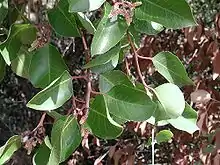Rhus ovata
Rhus ovata, also known as sugar sumac[1] or sugar bush, is an evergreen shrub to small tree that grows in chaparral in dry canyons and south-facing slopes below 1300 m in Southern California, Arizona and Baja California.
| Rhus ovata | |
|---|---|
 | |
| Scientific classification | |
| Kingdom: | Plantae |
| Clade: | Tracheophytes |
| Clade: | Angiosperms |
| Clade: | Eudicots |
| Clade: | Rosids |
| Order: | Sapindales |
| Family: | Anacardiaceae |
| Genus: | Rhus |
| Species: | R. ovata |
| Binomial name | |
| Rhus ovata | |
 | |
| Natural range | |
Distribution
The main Rhus ovata population range is from the central and Pacific region Baja California north into Pacific coastal Southern California, and also in the central Arizona region of the Mogollon Rim. Rhus ovata often hybridizes with Rhus integrifolia.[2]
Description
Rhus ovata ranges in height from 2–10 m (6.6–32.8 ft) and it has a rounded appearance. The twigs are thick and reddish in color. Its foliage consists of simple, dark green, leathery, ovate leaves that are folded along the midrib.[2] The leaf arrangement is alternate.
It blooms in April and May,[3] and its inflorescences which occur at the ends of branches consist of small, 5-petaled, flowers that appear to be pink, but upon closer examination actually have white to pink petals with red sepals. Additionally, the flowers may be either bisexual or pistillate. The fruit is a reddish, sticky drupe, and is small, about 6 – 8 mm in diameter.
Rhus ovata looks similar to Rhus integrifolia, but Rhus ovata can be distinguished by its leaves generally being folded rather than flat and more pointed than blunt as compared with the leaves of Rhus integrifolia.[2]
Ecology
The fruit and flowers are also popular with birds and butterflies and the plant itself provides good habitat for birds.
Uses
Rhus ovata was used by the Cahuilla to treat colds and coughs and by the Kumeyaay to ease child delivery. There are unconfirmed reports that Rhus ovata contains urushiol, the chemical irritant in plants such as poison ivy.[4]
Cultivation
Rhus ovata prefers well-drained soil in a sunny location, with little water once established, being a very drought-tolerant plant. It does not respond to formal boxed pruning well; however, as needed for wildfire fuel reduction or rejuvenation, occasional autumnal cutting, down to above the base crown, is done for new basal sprouting.
See also
- California chaparral and woodlands - (ecoregion)
- California coastal sage and chaparral - subecoregion
- Coastal sage scrub - (plant association)
- California montane chaparral and woodlands - subecoregion
References
- "Rhus ovata". Natural Resources Conservation Service PLANTS Database. USDA. Retrieved 21 October 2015.
- John M. Miller, Dieter H. Wilken (2017). "Rhus ovata, in Jepson Flora Project (eds.)". Jepson eFlora. Retrieved 1 August 2017.
- "Calflora: Rhus ovata". www.calflora.org. Retrieved 2017-08-02.
- "Sugar bush (Rhus ovata) berries fed the Cahuilla and Kumeyaay people -". www.ethnoherbalist.com. Retrieved 2017-08-02.
- Whitney, Stephen (1985). Western Forests (The Audubon Society Nature Guides). New York: Knopf. p. 447. ISBN 0-394-73127-1.
- Little, Elbert L. (1994) [1980]. The Audubon Society Field Guide to North American Trees: Western Region (Chanticleer Press ed.). Knopf. p. 523. ISBN 0394507614.
